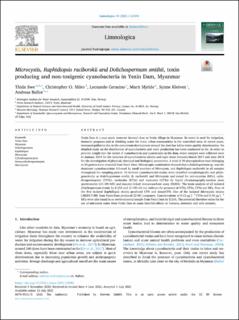| dc.contributor.author | Swe, Thida | |
| dc.contributor.author | Miles, Christopher O. | |
| dc.contributor.author | Cerasino, Leonardo | |
| dc.contributor.author | Mjelde, Marit | |
| dc.contributor.author | Kleiven, Synne | |
| dc.contributor.author | Ballot, Andreas | |
| dc.date.accessioned | 2021-07-23T07:28:42Z | |
| dc.date.available | 2021-07-23T07:28:42Z | |
| dc.date.created | 2021-07-17T17:02:05Z | |
| dc.date.issued | 2021 | |
| dc.identifier.citation | Limnologica. 2021, 90, 125901. | en_US |
| dc.identifier.issn | 0075-9511 | |
| dc.identifier.uri | https://hdl.handle.net/11250/2765156 | |
| dc.description.abstract | Yezin Dam is a man-made reservoir located close to Yezin village in Myanmar. Its water is used for irrigation, domestic purposes and as drinking water for many urban communities in the watershed area. In recent years, increased pollution due to the concurrent development around the dam has led to water quality deterioration. No detailed study on the distribution of cyanobacteria and toxin production has been conducted so far. In order to provide insight into the extent of cyanobacteria and cyanotoxins in the dam, water samples were collected once in January 2014 for the isolation of cyanobacterial strains and eight times between March 2017 and June 2018 for the investigation of physical, chemical and biological parameters. A total of 99 phytoplankton taxa belonging to 50 genera were recorded from Yezin Dam. Microscopic examination showed that a Dolichospermum sp. was the dominant cyanobacterium followed by small numbers of Microcystis, and Raphidiopsis raciborskii in all samples throughout the sampling period. 15 isolated cyanobacterial strains were classified morphologically and phylogenetically as Dolichospermum smithii, R. raciborskii and Microcystis and tested for microcystins (MCs), cylindrospermopsins (CYNs), saxitoxins (STXs) and anatoxins (ATXs) by liquid chromatography-tandem mass spectrometry (LC–MS/MS) and enzyme-linked immunosorbent assay (ELISA). The toxin analysis of all isolated Dolichospermum strains by ELISA and LC–MS did not indicate the presence of ATXs, STXs, CYNs nor MCs. Four of the five isolated Raphidiopsis strains produced CYN and deoxyCYN. One of the isolated Microcystis strains (AB2017/08) from Yezin Dam produced 22 MC congeners. Concentrations of 0.12 μg L−1 CYNs and 0.34 μg L−1 MCs were also found in an environmental sample from Yezin Dam by ELISA. The potential therefore exists for the use of untreated water from Yezin Dam to cause harmful effects on humans, domestic and wild animals. | en_US |
| dc.language.iso | eng | en_US |
| dc.publisher | Elsevier | en_US |
| dc.rights | Navngivelse 4.0 Internasjonal | * |
| dc.rights.uri | http://creativecommons.org/licenses/by/4.0/deed.no | * |
| dc.title | Microcystis, Raphidiopsis raciborskii and Dolichospermum smithii, toxin producing and non-toxigenic cyanobacteria in Yezin Dam, Myanmar | en_US |
| dc.type | Peer reviewed | en_US |
| dc.type | Journal article | en_US |
| dc.description.version | publishedVersion | en_US |
| dc.rights.holder | © 2021 The Author(s). | en_US |
| dc.source.pagenumber | 9 | en_US |
| dc.source.volume | 90 | en_US |
| dc.source.journal | Limnologica | en_US |
| dc.identifier.doi | 10.1016/j.limno.2021.125901 | |
| dc.identifier.cristin | 1922002 | |
| dc.source.articlenumber | 125901 | en_US |
| cristin.ispublished | true | |
| cristin.fulltext | original | |
| cristin.qualitycode | 1 | |

